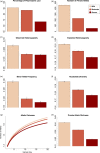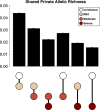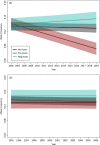Sarcoptic mange severity is associated with reduced genomic variation and evidence of selection in Yellowstone National Park wolves (Canis lupus)
- PMID: 33664786
- PMCID: PMC7896714
- DOI: 10.1111/eva.13127
Sarcoptic mange severity is associated with reduced genomic variation and evidence of selection in Yellowstone National Park wolves (Canis lupus)
Abstract
Population genetic theory posits that molecular variation buffers against disease risk. Although this "monoculture effect" is well supported in agricultural settings, its applicability to wildlife populations remains in question. In the present study, we examined the genomics underlying individual-level disease severity and population-level consequences of sarcoptic mange infection in a wild population of canids. Using gray wolves (Canis lupus) reintroduced to Yellowstone National Park (YNP) as our focal system, we leveraged 25 years of observational data and biobanked blood and tissue to genotype 76,859 loci in over 400 wolves. At the individual level, we reported an inverse relationship between host genomic variation and infection severity. We additionally identified 410 loci significantly associated with mange severity, with annotations related to inflammation, immunity, and skin barrier integrity and disorders. We contextualized results within environmental, demographic, and behavioral variables, and confirmed that genetic variation was predictive of infection severity. At the population level, we reported decreased genome-wide variation since the initial gray wolf reintroduction event and identified evidence of selection acting against alleles associated with mange infection severity. We concluded that genomic variation plays an important role in disease severity in YNP wolves. This role scales from individual to population levels, and includes patterns of genome-wide variation in support of the monoculture effect and specific loci associated with the complex mange phenotype. Results yielded system-specific insights, while also highlighting the relevance of genomic analyses to wildlife disease ecology, evolution, and conservation.
Keywords: RAD‐sequencing; ectoparasite; genetics; infection severity; mite infestations; natural selection; sarcoptic mange; wildlife disease.
© 2020 The Authors. Evolutionary Applications published by John Wiley & Sons Ltd.
Conflict of interest statement
None declared.
Figures







Similar articles
-
Social environment and genetics underlie body site-specific microbiomes of Yellowstone National Park gray wolves (Canis lupus).Ecol Evol. 2021 Jun 21;11(14):9472-9488. doi: 10.1002/ece3.7767. eCollection 2021 Jul. Ecol Evol. 2021. PMID: 34306636 Free PMC article.
-
Sarcoptic mange in the Scandinavian wolf Canis lupus population.BMC Vet Res. 2016 Jul 27;12(1):156. doi: 10.1186/s12917-016-0780-y. BMC Vet Res. 2016. PMID: 27459965 Free PMC article.
-
New techniques for an old disease: sarcoptic mange in the Iberian wolf.Vet Parasitol. 2011 Sep 27;181(2-4):255-66. doi: 10.1016/j.vetpar.2011.04.036. Epub 2011 Apr 29. Vet Parasitol. 2011. PMID: 21600696
-
Sarcoptic mange: An emerging panzootic in wildlife.Transbound Emerg Dis. 2022 May;69(3):927-942. doi: 10.1111/tbed.14082. Epub 2021 May 2. Transbound Emerg Dis. 2022. PMID: 33756055 Review.
-
Sarcoptic mange and production performance of swine: a review of the literature and studies of associations between mite infestation, growth rate and measures of mange severity in growing pigs.Vet Parasitol. 1995 Dec;60(3-4):249-64. doi: 10.1016/0304-4017(95)00795-3. Vet Parasitol. 1995. PMID: 8747908 Review.
Cited by
-
Non-Invasive Molecular Survey of Sarcoptic Mange in Wildlife: Diagnostic Performance in Wolf Faecal Samples Evaluated by Multi-Event Capture-Recapture Models.Pathogens. 2021 Feb 20;10(2):243. doi: 10.3390/pathogens10020243. Pathogens. 2021. PMID: 33672583 Free PMC article.
-
Social environment and genetics underlie body site-specific microbiomes of Yellowstone National Park gray wolves (Canis lupus).Ecol Evol. 2021 Jun 21;11(14):9472-9488. doi: 10.1002/ece3.7767. eCollection 2021 Jul. Ecol Evol. 2021. PMID: 34306636 Free PMC article.
-
Genomic heterozygosity is associated with parasite abundance, but the effects are not mediated by host condition.Evol Ecol. 2023;37(1):75-96. doi: 10.1007/s10682-022-10175-8. Epub 2022 Apr 7. Evol Ecol. 2023. PMID: 36568713 Free PMC article.
-
Genomic association with pathogen carriage in bighorn sheep (Ovis canadensis).Ecol Evol. 2021 Mar 2;11(6):2488-2502. doi: 10.1002/ece3.7159. eCollection 2021 Mar. Ecol Evol. 2021. PMID: 33767816 Free PMC article.
-
Cross-continental comparison of parasite communities in a wide-ranging carnivore suggests associations with prey diversity and host density.Ecol Evol. 2021 Jul 13;11(15):10338-10352. doi: 10.1002/ece3.7837. eCollection 2021 Aug. Ecol Evol. 2021. PMID: 34367579 Free PMC article.
References
-
- Abbas, A. , Lichtman, A. H. , & Pillai, S. (2016). Basic immunology: Functions and disorders of the immune system. New York, NY: Elsevier Inc.
-
- Aguilar, A. , Roemer, G. , Debenham, S. , Binns, M. , Garcelon, D. , & Wayne, R. K. (2004). High MHC diversity maintained by balancing selection in an otherwise genetically monomorphic mammal. Proceedings of the National Academy of Sciences, 101(10), 3490–3494. 10.1073/pnas.0306582101 - DOI - PMC - PubMed
LinkOut - more resources
Full Text Sources

